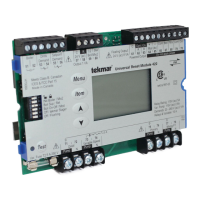tekmar Control Systems Ltd., Canada
tekmar Control Systems, Inc., U.S.A.
Head Office: 5100 Silver Star Road
Vernon, B.C. Canada V1B 3K4
(250) 545-7749 Fax. (250) 545-0650
Web Site: www.tekmarcontrols.com
Product design, software and literature are Copyright © 2009 by:
tekmar Control Systems Ltd. and tekmar Control Systems, Inc.
12 of 12
All specifications are subject to change without notice.
Printed in Canada. W 422 - 03/09.
Universal Reset Module 422; Two tekmarNet
®
4, Mixing, Boiler, DHW & Setpoint
Control Microprocessor PID control; This is not a safety (limit) control
Packaged weight 1.87 lb. (848 g)
Dimensions 3-5/8” H x 5-3/8” W x 9/16” D (92 x 137 x 14 mm)
Approvals CSA C US, CSA/UL 61010-1, meets Class B: ICES and FCC Part 15
Ambient conditions Indoor use only, 32 to 122°F (0 to 50°C)
RH
80% to 88°F (31°C), down to 50% from 104 to 122°F (40 to 50°C)
Altitude <6560 feet (2000 m), Installation Category II, Pollution Degree 2
Power Supply Provided by interconnected Zone Manager
DHW Pump Relay 115 V (ac) 5 A
Primary Pump Relay 115 V (ac) 5 A
Mixing P1 Pump Relay 115 V (ac) 5 A
Variable Speed Pump 115 V (ac) 2.5 A, fuse T2.5 A 250 V
Combined Load 10 A Maximum (for DHW, Primary, Mixing and Variable Speed Pump)
Floating Action Output 24 V (ac) 8 VA Maximum
Modulation Output 0-10 V Minimum 2500
Boiler Relay 115 V (ac) 5 A
Demands 20-260 V (ac) / 0.1 VA @ 24 V
Sensors NTC thermistor, 10k @ 77°F (25°C ± 0.2°C) ß=3892
–Included Outdoor Sensor 070 and 2 of Universal Sensors 082
Technical Data
The installer must ensure that this control and its wiring are isolated and / or shielded from strong sources of electromagnetic
noise. Conversely, this Class B digital apparatus complies with Part 15 of the FCC Rules and meets all requirements of
the Canadian Interference-Causing Equipment Regulations. However, if this control does cause harmful interference to
radio or television reception, which is determined by turning the control off and on, the user is encouraged to try to correct
the interference by re-orientating or relocating the receiving antenna, relocating the receiver with respect to this control,
and / or connecting the control to a different circuit from that to which the receiver is connected.
Cet appareil numérique de la classe B respecte toutes les exigences du Règlement sur le matériel brouilleur du Canada.

